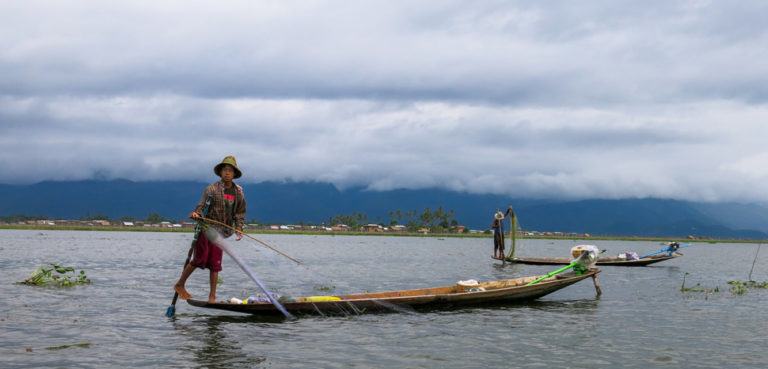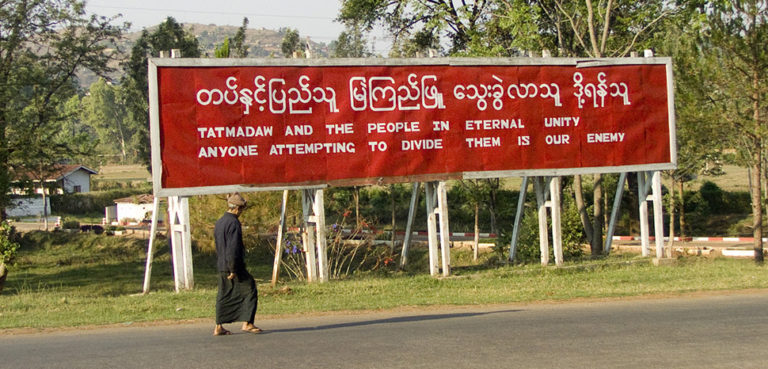Down a dirt road in Karenni State, in a jungle compound hidden from the air by camouflage netting and tarps, the Karenni Nationalities Defense Force (KNDF), a leading resistance group fighting in the Myanmar civil war, operates a drone unit. Inside various huts, workstations are set up for manufacturing, painting, and repairing the physical drones, as well as for programming and electronics. One station even features a whiteboard for planning. Beneath each workstation is a bomb shelter. “We sleep underground,” said the unit’s 27-year-old leader, who goes by the name “3D.”
Since the KDNF retook about 80% of the state’s territory from government forces, direct clashes and exchanges of small arms fire have become less frequent. However, every civilian and soldier in Karenni State lives under the constant threat of airstrikes, as only the junta has airplanes and helicopters provided by Russia and China. Drones have become the only airborne weapon the resistance possesses, and the drone unit is crucial for the KNDF and other resistance groups in maintaining the territory they now hold.
In the early part of the current fighting, which began in 2021 after the junta seized power in a military coup, the country’s ethnic majority, the Bamar, as well as educated city dwellers, joined the ethnic resistance armies that had been at war with the government since 1948. At first, experienced ethnic jungle fighters were distrustful of cooperating with the Bamar, who had always viewed the ethnic war as separate from their own political struggles and protests for democracy. Even after the ethnic groups came to understand that the war was now everyone’s war, and that the Bamar also wanted to do their part to oust the military government, there remained the very real issue of skill and endurance. The ethnic fighters were used to living and fighting in the jungles, as their parents and grandparents had before them. In contrast, these young, educated, often English-speaking city dwellers—accustomed to modern conveniences and having never held a gun—seemed more like a liability than an asset.
However, this is where 3D and others like him in ethnic armies across the country were able to convince the resistance that they had something to offer. Using a combination of commercial drones, plans downloaded from the Internet, and YouTube tutorials, they were able to manufacture surveillance and combat drones that ultimately turned the tide of battle.
“We’re all gamers,” laughed 3D, explaining that his team, all at least five years younger than himself, were well-versed in internet research and tech-savvy problem-solvers who enjoyed developing new technologies. “We are collecting resources from all over the internet,” 3D explained. “And we develop our designs. In some cases, we copy some of the ready-made ones.” They also use 3D printers to make components, as it can take up to five months to receive replacement parts, which must be transported through the jungle from Thailand or China.
When the coup came, many people found their education abruptly halted. 3D, who had been working in IT, and some of the older soldiers had completed their education before joining the resistance. Some were in the middle of their studies, while others didn’t even get the chance to finish high school. This suggests that not only are these young people determined and resilient, but they must also be exceptionally bright to have accomplished so much without formal training.
As impressive as it is that these young people are able to manufacture some of the most advanced technology in the jungle with varying levels of education, a critical point cannot be overlooked: the government has shut down electricity, phone service, and internet access to Karenni State. The camps where soldiers and displaced people live lack running water. To make matters worse, laptops are in extremely short supply, and most of the research the drone team does is done on their cell phones, which are charged using solar chargers or large power banks powered by generators. However, the generators require fuel, which has to be smuggled into the country and can be incredibly expensive. For internet access, they rely on Starlink, which, again, requires power from solar chargers or generators.
3D explained that each drone’s bomb capacity depends on the size of the drone. Their multi-copter drones can carry bombs ranging from 5 kg to 20 kg. The larger drones can carry up to 100 kg, although the biggest ones are currently out of service. The smallest drones in their arsenal can carry as little as 30 grams. Regarding the bombs, 3D says: “We put a lot of explosives to get the power. When we hit the bunker or the building, it will explode. And inside is shrapnel.” The shrapnel consists of iron balls.
When asked about the types of bombs used by the junta, 3D notes similarities, stating that the State Administration Council (SAC) drones also use large bombs, including those that drop 40 mm grenades. “They also use the big ones, bigger than the 40 mm.” The larger bombs range from 120 mm to 200 mm, and the drones can carry multiple explosives. “If the bomb is like 40 mm, we can carry up to 30 to 40 munitions.” These drones have a range of up to 5 km and fly at an altitude of 800 to 1,000 meters. “This helps avoid obstacles such as trees or power lines and ensures the drones are less vulnerable to being shot down,” he explained.
For the KNDF, drones are a crucial asset. “It’s a game-changing weapon. We don’t have the fighter jet, we don’t have the helicopter, so we rely on the drone for our airstrikes,” he said.
3D discussed the difficulties the KNDF is facing with jammers, noting that they don’t have military-grade GPS systems. “We lost a lot of our drones and jamming devices,” he explained. Jammers interfere with the drone’s signals, including GPS and camera feeds, which means that when a drone is within the jammer’s range, it loses control and either flies away or crashes into something like a tree. However, the jammer doesn’t directly cause the drone to crash; it simply takes away the ability to control it. When asked if they had devices to counter the jammers, 3D said, “No, we can’t jam the jammer because it releases random signals.” This, he admitted, is a terrifying disadvantage. Yet despite the setback, 3D explained that even with the jammers in place, if enough drones are deployed, using differing signals, some will still succeed.
The SAC is currently using a combination of landmines, artillery, mortars, air support and drone jamming towers to hold the cities it has seized. If the KNDF had a large enough number of drones, they would be able to launch attacks on the SAC’s strongest positions and prevail. But as it is, they have to pick their battles carefully to avoid wasting drones.
It is remarkable that the Karenni were able to form an army in 2021, largely from people with no formal military training and little combat experience, with few weapons, a small number of soldiers, and no aircraft. Through hard work and intelligent creativity, they were able to retake most of their state. However, the war will not end unless the West provides political recognition for the ethnic resistance forces and political parties that are now effectively governing their states. Additionally, the West must supply these ethnic resistance armies with weapons, particularly the ability to shoot down aircraft. Their perseverance demonstrates their resolve and determination—they just need a little help to finish the job and realize their dream of self-governance.
The views expressed in this article belong to the author(s) alone and do not necessarily reflect those of Geopoliticalmonitor.com.




